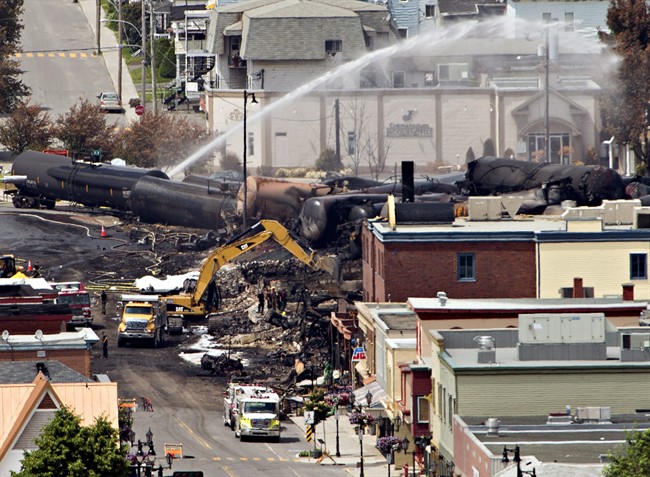The warnings to the federal government have been clear for some time – provide and enforce sufficient oversight for transporting dangerous goods, or risk putting the safety of citizens in jeopardy.

Though not all types of oil are classified as “regulated dangerous goods,” the crude oil aboard the train involved in last weekend’s Lac-Megantic disaster was, a Transport Canada spokeswoman said.
And now, questions are beginning to swirl around the type of container used to transport the oil – one known to puncture during accidents.
In a stark warning issued a year and a half ago, the federal environment commissioner cautioned that public safety is increasingly at risk because of a failure on the government’s part to provide and enforce sufficient oversight of transporting dangerous goods — including oil — by road, rail, air and ship.
Since that December 2011 report, an unmanned train carrying combustible crude oil has ravaged one Quebec town, crude oil gushed from a damaged rail car in Saskatchewan and hundreds of barrels of oil spilled after a derailment in northern Ontario, to name a few events.

Transport Canada agreed with the audit at the time, committing to address the concerns in waves to be completed by April 2013.
The government has yet to fulfill all recommendations then-environment commissioner Scott Vaughan included in his report, though it is on its way, Transport Canada spokeswoman Maryse Durette wrote in an emailed response.
But even at the time of the environment commissioner’s report, the faults he identified were not new. “Many of the weaknesses we found in Transport Canada were identified more than five years ago and have yet to be fixed,” he wrote at the time.
Weaknesses Vaughan identified include the fact that Transport Canada lacks the means to determine the extent to which companies transporting dangerous goods obey rules for safely shipping them, and whether compliance is getting better or worse from year to year.
During a briefing late Tuesday afternoon, Assistant Deputy Minister for Safety and Research Gerard McDonald said that although Transport Canada has implemented a number of its commitments, a number have yet to be “fully resolved.”
READ MORE: Crude awakening: a Global News series on oil
“Transport Canada is on schedule to meet its commitments,” Durette wrote in her email, despite the final deadline of April 2013 having passed three months ago.
Durette noted Transport Canada has fulfilled two of its six commitments: bolstering its compliance monitoring and enhancing follow-up procedures, and implementing a risk-based inspection process.
READ MORE: Lac-Megantic explosion raises questions about transporting oil in B.C.
Transport Minister Denis Lebel tried to assuage concerns about his government’s handling of railway safety during a visit to the devastated town of Lac-Megantic Monday evening.
“Over the past few days, there have been, very understandably, a number of questions about whether we are doing enough to keep our railways safe,” he said in a statement. “Since 2007, train accidents have gone down by 23 per cent and train derailments are down by 26 per cent.”

According to federal legislation regulating the transportation of dangerous goods, cargo must be shipped in containers manufactured to a Transport Canada-approved standard, among other requirements, the department official explained.
Transport Canada and the Transportation Safety Board of Canada have inspectors on the ground in Lac-Megantic, where a catastrophic crude oil train derailment eviscerated the small town, killing at least 13 people and leaving nearly 40 others missing.
Those officials will determine whether the train’s owners, Montreal, Maine & Atlantic Railway, followed the federal rules. But as the investigation is ongoing, it would be inappropriate to comment further, Durette wrote.
Still, questions are already being raised about the type of tankers used to transport the combustible cargo. The tank cars fall under “class 111-A,” a type known to puncture during accidents. The Transportation Safety Board has publicly called for improvements to these types of tankers.
During a media briefing Tuesday, Transportation Safety Board chief investigator Don Ross said these “common” tank cars are the “general-service class of tank car that are used to carry products like, in this case, petroleum products.”
Levels of defence – steel thickness and rollover protection, for example – vary depending on how hazardous the cargo is considered. Ross reiterated the board’s calls for improvements to that 111-class car, but stopped short of pointing to them as the reason for the explosions.
“We’re going to establish here whether everything that was done here met the existing requirements,” he told reporters. “But I just want to make the comment and reinforce that the TSB has made recommendations about making improvements to the 111 cars.”




Comments